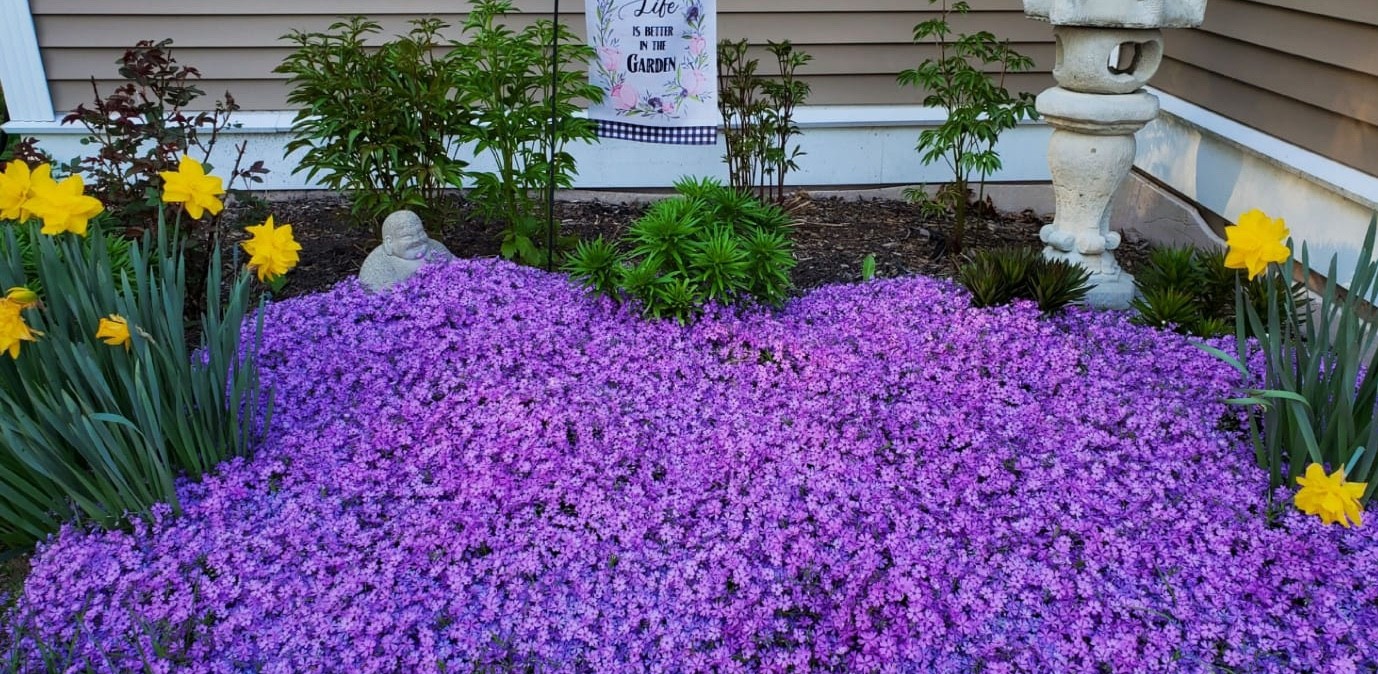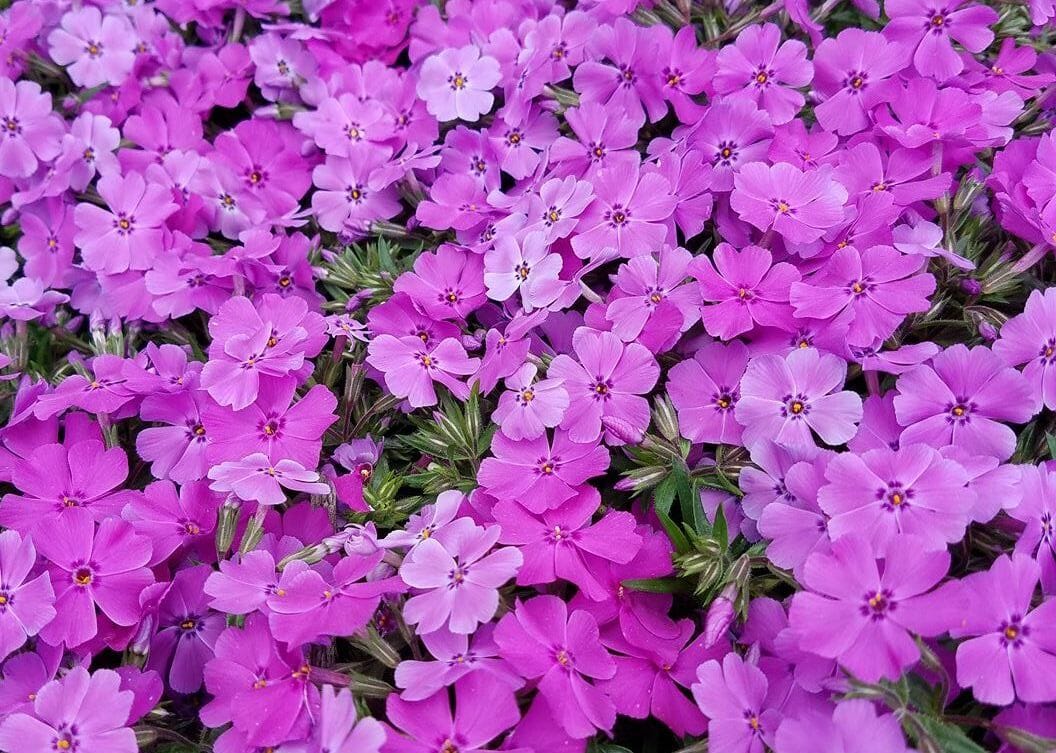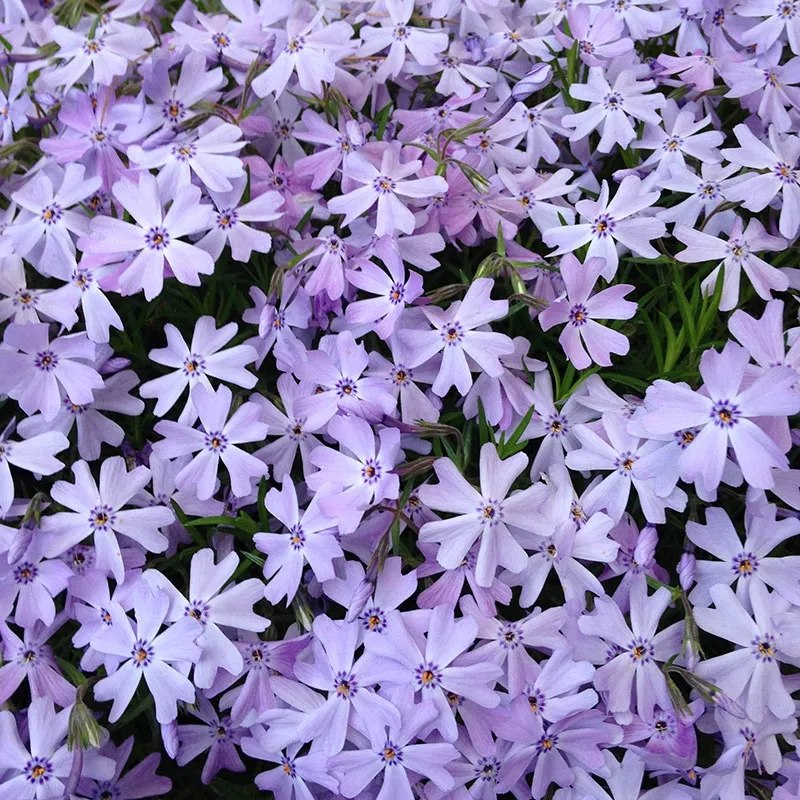Are you looking to add a pop of color to your home to break the monotony of green grass and plants?
There are various plants at your disposal that bloom with beautiful, colorful flowers that will make your property stunning, an excellent example being a creeping phlox lawn.
The best kind of ground cover is versatile, low-maintenance, and low-growing, as that will help create a beautiful carpet-like cover.
You can choose a ground cover to fill empty spaces, for aesthetic purposes, or both.
Keep reading for a detailed look at the creeping phlox lawn, including its pros and cons, design ideas, maintenance needs, and the different varieties of this plant.
What Is Creeping Phlox?

Creeping Phlox (p. subulata) is also known as moss pink or mountain phlox is a dwarf, semi-evergreen, perennial, low-growing, carpet-growing plant that’s native to North America.
This ground cover is drought and erosion tolerant, resistant to deer, pollution, and salt, and thrives in the sun.
While the creeping phlox has needle-shaped, gorgeous leaves, you will mostly see the flowers during the blooming season.
This plant produces lilac-blue, pink, white, and purple flowers. The flowers are nearly one inch across and have five petals.
A mature creeping phlox is 9 to 18 inches wide and 6 to 12 inches tall and thrives in well-drained, loamy, alkaline, neutral, and acidic soil. It blooms in summer and spring.
Also read:
- How To Plant Dymondia Ground Cover
- Simple Xeriscape Ideas On A Budget
- 12 Cheap No Grass Backyard Ideas
- Chamomile Ground Cover
Can Creeping Phlox Be Used As A Lawn?
Yes, creeping phlox can be used as a lawn. You can plant creeping phlox on your lawn and see it grow into a carpet-like ground cover that will transform your yard into a vibrant, flowery place. This plant’s attractive green hue stays pretty and fresh until winter arrives.
The leaves develop cushions resembling moss and can withstand light traffic. You can use creeping phlox to cover spaces between your patio pavers and pathways.
How To Grow Creeping Phlox Lawn
Are you looking to introduce creeping phlox to your lawn?
Here’s how to do so:
Supplies
- The Starter plants
- Trowel
- Animal manure or compost
- Spade
Procedure
- Visit a nursery or garden center to find the starter plants for creeping phlox. Choose healthy ones with bright green, bushy foliage.
- Select the right spot to plant creeping phlox, ensuring it has partial shade or receives the sun fully.
- Dig the soil up to 12-14 inches deep using a spade and ensure you loosen the soil. Additionally, remove weeds and rocks and break up any big dirt clods.
- Spread organic matter like compost on the soil, creating 2-4 inches of cover. Mix the organic matter with the soil.
- Dig the hole to plant the creeping phlox using a garden trowel. Ensure the hole is about double the container that has the starter plants. Space the holes by around a foot when planting many plants.
- Carefully take the plants out of the containers and insert them in holes. Do not plant the root ball’s top too deep to keep the creeping phlox from rotting.
- Cover the roots with soil and gently pat them.
- Water the plants, ensuring the soil is moistened up to 6-8 inches deep. Water the plants moderately until new growths come up.
Read More: Flowering Ground Covers For Shade
Creeping Phlox Lawn Care

Creeping phlox is low-maintenance and doesn’t require a lot of special care. However, there are things you’ll need to do to keep a vibrant and healthy lawn made of creeping phlox.
1. Watering
Although mature creeping phlox is drought-tolerant, water this plant once a week, especially during prolonged periods of no rain or summer.
Creeping phlox needs low to moderate watering.
2. Winterizing
Creeping phlox doesn’t need special care to withstand the harsh conditions of winter. However, you can thickly mulch (at least 3 inches) around the plants once the ground freezes to keep them from suffering frost damage by regulating the temperatures.
3. Pruning
You do not have to prune creeping phlox, but doing so encourages a rebloom, promoting the growth of a denser, more attractive cover. Develop a neater form by trimming the foliage once the blooming season passes.
4. Fertilizing
Working a slow-acting, general-purpose granular fertilizer into your lawn soil in spring will keep your creeping phlox lawn healthy.
5. Weeding
2 to 3 inches of organic mulch is sufficient to suppress unwanted plants. Lay leaves, pine barks, or straw around the creeping phlox as weed control, protect the roots, and retain moisture.
Creeping Phlox Lawn Pros
- It offers a stunning, colorful ground cover
- Low maintenance
- Resistant to drought, salt, deer, and pollution
- Erosion tolerant
- Versatile and pairs well with other plants
Creeping Phlox Lawn Cons
- It can only withstand light foot traffic.
- Short Blooming Period: While the flowers of creeping phlox are stunning, they only bloom for a short period of time in the spring
- Maintenance: Creeping phlox requires some maintenance to keep it looking its best.
Design Ideas For A Creeping Phlox Lawn
You can incorporate creeping phlox into your home in various ways. These include:
- Empty spots to make your lawn more aesthetically appealing and fuller.
- Fill stone wall crevices to develop an overgrown look.
- On top of retaining or rock walls letting, the creeping phlox creep creating a bloom that resembles a waterfall. It makes the hardscaping colorful and stunning.
- Use it for erosion control on slopes.
- Plant creeping phlox at raised beds’ edge. The plant will spill over and soften the hard lines.
- If your garden bed is sloped, fill it using creeping phlox. It won’t add extra inches to the slope’s height.
- Cover hardscaping for a beautiful lawn in summer.
Also Read:
Common Problems With Creeping Phlox Lawn
Creeping phlox is not susceptible to many issues, provided you grow it under the proper conditions and care for it. Nonetheless, pay attention to these problems.
1. Poor Blooming
The best bloom from creeping phlox requires the right environmental conditions. The conditions that could cause poor flowering include little light, excess nitrogen in the soil, incorrect pruning, leggy stems, and powdery mildew.
2. Yellowing Foliage
When creeping phlox leaves turn yellow, it is often because of different problems, including overwatering, diseases, and little light.
Ensure these plants don’t stay in the shade for prolonged periods during the day. Also, your lawn needs proper drainage.
3. Hollow Center
Not pruning creeping phlox can make the stems leggy and their center hollow. Stimulate new growth by pruning dead stems.
4. Diseases and Pests
A creeping phlox lawn isn’t susceptible to pests, but spider mites can be a problem in sunny and hot areas, while slugs can affect wet regions. You can eradicate these bugs using sticky pads or an appropriate spray.
Best Creeping Phlox For Lawn
a) Fran’s Purple Creeping Phlox
This variety’s flowers are rich purple, while the leaves are deep green. This vigorously growing plant develops a dense foliage mat. Fran’s Purple Creeping Phlox leaves are also smaller, and the entire plant is slightly shorter.
It spreads by about 1 to 2 inches annually and grows to 8 inches tall.
b) Sherwood Purple Creeping Phlox
This type of creeping phlox can grow up to 12 inches high, and its flowers are bright pink. It thrives in acidic, sandy, and normal soil, and its water requirements are moderate.
c) Home Fires Creeping Phlox
The bright-pink blooms and deep-green foliage will make your lawn delightful. A mature home fires creeping phlox is 18 to 24 inches wide and 4 to 6 inches tall.
d) Pink Ridge Creeping Phlox
This plant has pink flowers. The pink ridge is about 6 to 10 inches tall, 12 to 24 inches wide, and spreads 1 to 2 inches annually.
FAQs
How Far Will One Creeping Phlox Spread?
A single creeping phlox spreads to about 9 to 18 inches.
Does Creeping Phlox Need A Lot Of Water?
Creeping phlox does not require plenty of water. However, ensure the soil is moist after seeding or growing starter plants until the creeping phlox is established correctly.
Moreover, this plant will benefit from additional watering, particularly in summer or if you live in a dry area.
Is Creeping Phlox Poisonous To Humans?
This plant isn’t toxic to humans, farm animals, and pets.
Does Creeping Phlox Stay Green All Year?
Creeping phlox stays green throughout the year, but the leaves can turn a bit brown in dry or cold weather.
What Does Creeping Phlox Look Like When Not In Bloom?
When not in bloom, creeping phlox appears as a dense, low-growing mat of evergreen foliage that is typically around 4 to 6 inches tall. The leaves are small, needle-like and bright green in color.
Final Remarks
With colorful ground cover alternatives such as creeping phlox, your lawn must not be dull. This low-maintenance, sturdy, and resilient plant helps cover any unsightly slopes. Establish a creeping phlox lawn in the fall or spring. It will spread out, filling any bare spaces.

Hey there, I’m Derek Schew, a writer for Lawnholic.com, where we cover everything and anything related to lawns. As someone who’s spent countless hours tending to my own lawn, I’m passionate about sharing my knowledge and helping others achieve the perfect yard. From lawn care tips to product reviews, I’m committed to providing our readers with the most accurate and up-to-date information available. So whether you’re a seasoned lawn enthusiast or just getting started, I invite you to join our community and discover the joys of a lush, green lawn.

